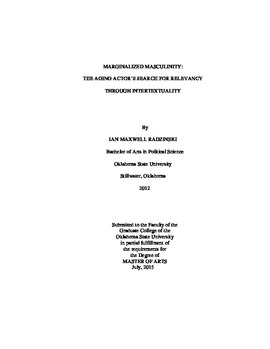| dc.contributor.advisor | Lewis, Lynn C. | |
| dc.contributor.author | Radzinski, Ian Maxwell | |
| dc.date.accessioned | 2016-09-29T18:42:29Z | |
| dc.date.available | 2016-09-29T18:42:29Z | |
| dc.date.issued | 2015-07-01 | |
| dc.identifier.uri | https://hdl.handle.net/11244/45303 | |
| dc.description.abstract | Throughout recent cinema, the masculine male identity has been showcased on-screen by various film stars both within the action genre and outside it. Specifically, Arnold Schwarzenegger, Sylvester Stallone, Jean-Claude Van Damme, and numerous others were products of the 1980s masculinity that stressed immense displays of exaggerated violence and hyperbolic musculature on-screen. The 1990s, however, ushered in a new type of masculinity � the emotionally responsive male figure. With this new type of masculinity came a transformation in the male�s former masculine character. This newly emerging masculine figure was marked not only by his newfound demonstration of emotion, but also by his social marginalization. Falling Down (1993), First Blood (1982), and many other films have focused their narratives on society�s relegation of the male lead to a reduced status in society. This study examines how two former popular figures in the cinema � Jean-Claude Van Damme and Michael Keaton in JCVD (2008) and Birdman (2014), respectively � were both narratively marginalized by a profession whose emphasis has heavily transformed since the 1980s. Each film presents the masculine male figure at a point in his profession where he is attempting to revitalize his career after spending years outside of Hollywood�s A-list. Through a visual rhetorical lens, this study assesses how JCVD (2008) and Birdman (2014) are prime vehicles for the actors to intertextually comment on their present, diminished positions in cinema. The intertextual commentary within each film draws on the former cinematic identities of these two male stars (Keaton as Batman and Van Damme as the quintessential action hero) and establishes a means through which the audience may understand how each star is commenting upon his former masculine male identity within each film. This essay also discusses how the study of rhetoric and intertextuality should be expanded to include such visual rhetorical realms as film. Through such scholars as Kenneth Burke and David Blakesley, this essay considers how the visual actions and verbal dialogue displayed on-screen advance a certain rhetorical �way of seeing� the masculine character or identity. | |
| dc.format | application/pdf | |
| dc.language | en_US | |
| dc.rights | Copyright is held by the author who has granted the Oklahoma State University Library the non-exclusive right to share this material in its institutional repository. Contact Digital Library Services at lib-dls@okstate.edu or 405-744-9161 for the permission policy on the use, reproduction or distribution of this material. | |
| dc.title | Marginalized Masculinity: The Aging Actor�s Search for Relevancy Through Intertextuality | |
| dc.type | text | |
| dc.contributor.committeeMember | Brooks, Ron | |
| dc.contributor.committeeMember | Menne, Jeff | |
| osu.filename | Radzinski_okstate_0664M_14175.pdf | |
| osu.accesstype | Open Access | |
| dc.description.department | English | |
| dc.type.genre | Thesis | |
